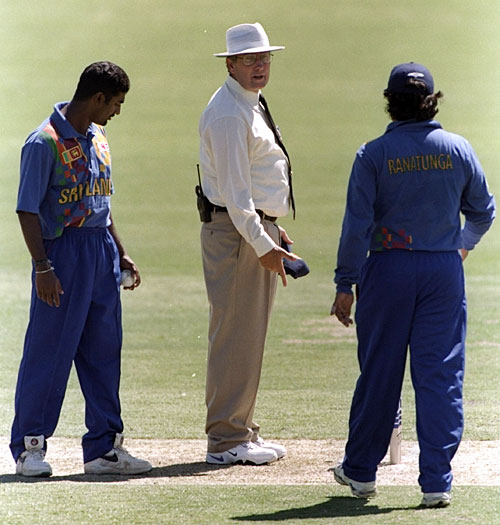Sri Lanka always had cricketers who made the world sit up and take notice.
Sidath Wettimuny, refined and understated, and Duleep Mendis, buccaneering and devil-may-care, were the early heroes of a nascent Test nation. Aravinda de Silva, one of the most graceful batsmen to play the game, was Sri Lanka's first true great. In an era of Brian Lara, Sachin Tendulkar and Ricky Ponting, Wasim Akram described de Silva as the most difficult batsman to bowl to. More recently, Mahela Jayawardene and Kumar Sangakkara have compiled over 10,000 Test runs each, putting them among the top ten run accumulators in history. And no discussion of Sri Lankan greats could even start without reference to Muttiah Muralitharan, arguably the greatest spin bowler of all time, who carried Sri Lanka's bowling attack almost single-handedly for much of his 18-year career.
But top-level sport is won and lost in the mind. One man was responsible for changing the mentality of the Sri Lankan team he captained and the individuals in it. In so doing, he forged a team that believed it could defeat all comers. Under Arjuna Ranatunga's leadership, Sri Lanka went from charming amateurs to World Cup winners. It didn't happen by chance.
Arjuna was born in Gampaha, a town outside Colombo, and went to school at the unfashionable Ananda College. In the pre-Test match era, schoolboy cricket was the pinnacle of the sport in the country, and the anglicised elite schools dominated both cricket and the back pages. Ananda College, established by the Buddhist Theosophist Society specifically to counter missionary activity, was the antithesis of the elite schools. It is well documented that a 15-year-old Arjuna was dismissed as a "sarong Johnnie" by an elderly member of the Sinhalese Sports Club when he first arrived. Colonial attitudes run deep in the colonised. Perhaps these early outsider experiences shaped Arjuna's belligerence.
He made his Test debut in the inaugural Test in Colombo in February 1982, at the age of 18. Though still a schoolboy, he led Sri Lanka's first Test fightback. Coming in at 34 for 4, Arjuna hit a fluid fifty, incidentally also Sri Lanka's first Test fifty. It was a mature and assured debut. When the match finished, he went back to school. But it is not for his batting that Arjuna is remembered.
Arjuna captained Sri Lanka on their 1995-96 tour to Australia, a pivotal tour in the team's development. On arrival, they were regarded as a harmless and exotic distraction. By the time they left, they had demonstrated a capacity for a fight. It was an ugly tour in many ways. It is said racial vilification was never far from the surface, and the tour is most remembered for the controversy surrounding Muralitharan.
Arjuna was a constant irritant to opponents throughout his career. His policy seemed to be to go where the exchanges were spikiest, and get stuck in
Murali, already an established Test player, with 22 caps, was called for throwing. Arjuna's response could have come out of the manual that showed you how to forge a unified team. He backed Murali unconditionally, remonstrating forcefully and publicly with Australian umpires. Meek capitulation would not only have imperilled Murali's career, it would have set the self-esteem of the team back severely. Instead, Arjuna demonstrated the fighting qualities of the warrior prince he was named after.
Although Sri Lanka were outplayed by Australia, they knocked out West Indies to make the final of the triangular ODI series. In the process, they honed a strategy that was a vital part of their World Cup win. Romesh Kaluwitharana and Sanath Jayasuriya opened the batting with a blaze of boundaries. Sri Lanka's blitzkrieg approach at the top of the innings was born.
Arjuna was a constant irritant to opponents throughout his career. His policy seemed to be to go where the exchanges were spikiest, and get stuck in. A powerful man, broad in the shoulder and forearm, he seemed immune to intimidation. He was certainly effective at riling opponents. I recall an apoplectic Alec Stewart screaming at his own fielders while Arjuna ambled between the wickets.
Arjuna was also influential in the policy of seeking cricketers from the provinces. At the time, Sri Lanka struggled to harness cricketing talent outside Colombo. Jayasuriya was an early beneficiary of Arjuna's vision. Arjuna brought Jayasuriya from his home town, Matara, to Colombo, and even put him up. Jayasuriya, now chairman of selectors, has given five young cricketers from the north and the eastern regions central U-19 contracts. Arjuna's legacy lives on.
By refusing to back down, by returning all and any insult with interest, Arjuna proved to the opposition, and more importantly to his own team, that Sri Lanka had earned the right to compete as equals. He certainly blew away the last remnants of the post-colonial mindset that had been directed at him at the SSC.
Sri Lanka's two most hailed triumphs, the 1996 World Cup and their first Test win in England, occurred under his leadership. His successors, notably the statesmanlike Jayawardene and the fiercely intelligent Sangakkara, have benefited from his groundwork. Different captains for different times, they had no need of Arjuna's in-your-face bellicosity. The teams they inherited knew they had it in them to stand toe to toe with the best.

No comments:
Post a Comment